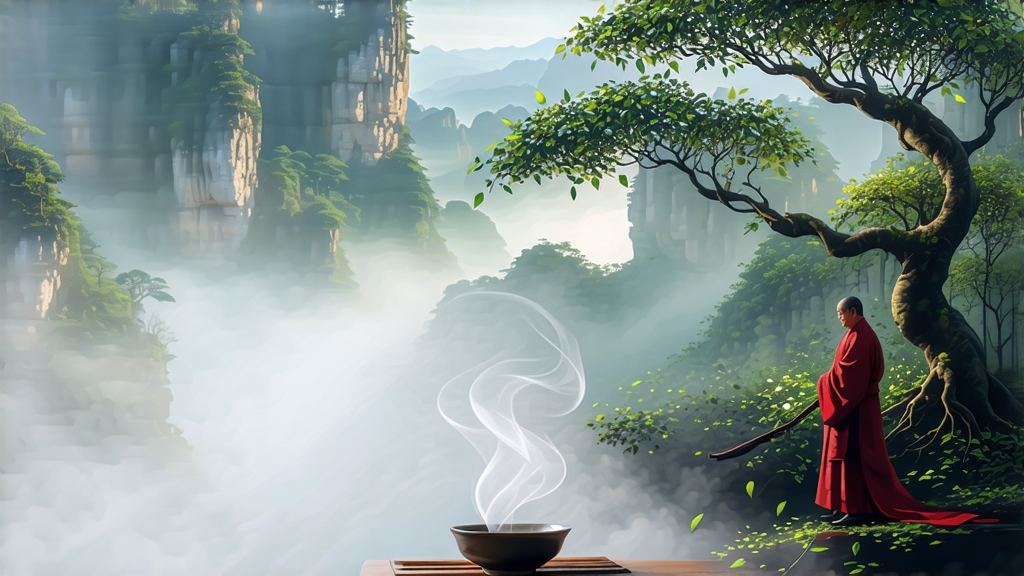
High above the Nine-Bend Stream, where the Wuyi Range folds into a maze of basalt cliffs and drifting mist, tea is not merely cultivated—it is quarried from stone. Here, in the 60-kilometre-long core scenic zone of northern Fujian, the name Da Hong Pao (“Big Red Robe”) is spoken with the same reverence wine lovers reserve for Romanée-Conti. To understand this oolong is to step into a palimpsest of Song-dynasty poetry, Ming-era imperial tribute records, and modern auction-house frenzy, all scented with the flint-and-honey perfume that locals call yanyun—“rock rhyme.”
The origin myth is told in every tea house in Xingcun port: a Ming scholar, hurrying to the capital for the imperial exam, falls ill at the Tianxin Yongle temple. A monk brews him a liquor from leaves plucked halfway up Jiulongke (“Nine-Dragon Hollow”); the scholar revives, tops the exam, and returns in crimson robes to thank the bush that saved him. He drapes the robe over the tea tree; the bark reddens, the leaves absorb the honour, and Da Hong Pao is born. Apocryphal or not, the tale fixes three ideas that still govern the tea’s identity: spiritual provenance, imperial prestige, and a blood-red colour that appears in both leaf rim and liquor.
Botanically, Da Hong Pao is not a single cultivar but a stylistic summit reached by several related Wuyi bushes. The original six “mother trees,” clinging to a 2-metre-wide ledge at the entrance of Nine-Dragon Gorge, were last harvested in 2006; their genetic offspring now populate the narrow band of volcanic soil between 300–800 m elevation known as zhengyan (“true cliff”). The most prestigious clones—Qidan, Beidou, and the commercially dominant Que She (“Sparrow Tongue”)—mature slowly in mineral-rich weathered tuff, developing the small, thick, jade-backed leaves that can withstand the marathon roast that follows plucking.
The crafting calendar begins around the third day after Grain Rain, when morning fog lingers until 10 a.m. and the leaf’s moisture content balances at 75 %. Pickers take only the central 3–4 leaves, still half-closed, in what is termed kai mian cai—“opening-face pick.” From here the tea embarks on a 20-hour odyssey that blurs the line between agriculture and metallurgy. First comes solar withering on bamboo racks angled toward the southeast sun; the leaf must lose 10 % weight without losing turgor, a window of roughly 45 minutes. Indoor yaoqing (“rock shaking”) follows: the leaves are tumble-turned in 70 r.p.m. bamboo drums for three rounds, each 5 minutes shorter than the last, coaxing the edges to oxidise while the core stays green. When the ambient perfume shifts from cut grass to ripe peach, the master knows the 30 % oxidation target has been met and moves to kill-green in 280 °C woks, hand-pressing the leaf for eight seconds at a time—long enough to halt enzymes, short enough to preserve the cliff-born minerals.
What distinguishes Da Hong Pao from all other oolongs is the charcoal roast. In subterranean pits lined with local loess, the tea is laid on sieves 40 cm above a banked fire of longan or lychee wood that has been reduced to embers over 12 hours. For eight successive nights the leaf is raked, turned, and cooled, absorbing smokeless heat that caramelises residual sugars and fixes the signature “rock rhyme.” A top-grade tea may endure three such cycles across three months, losing another 15 % mass and gaining a patina of dark chocolate, pipe tobacco, and the scent of hot river stones after rain.
To brew Da Hong Pao like a Wuyi native you need three tools: a 120 ml zisha “shipiao” teapot whose walls have been seasoned by five years of cliff tea, a fair-glass to arrest the pour, and spring water that has never seen plastic. The leaf-to-water ratio is aggressive—8 g for 120 ml—because the roast has driven much aroma into the core. The first infusion, 10 seconds at 98 °C, is discarded as xihu (“awakening the tiger”); the